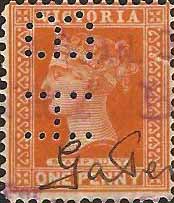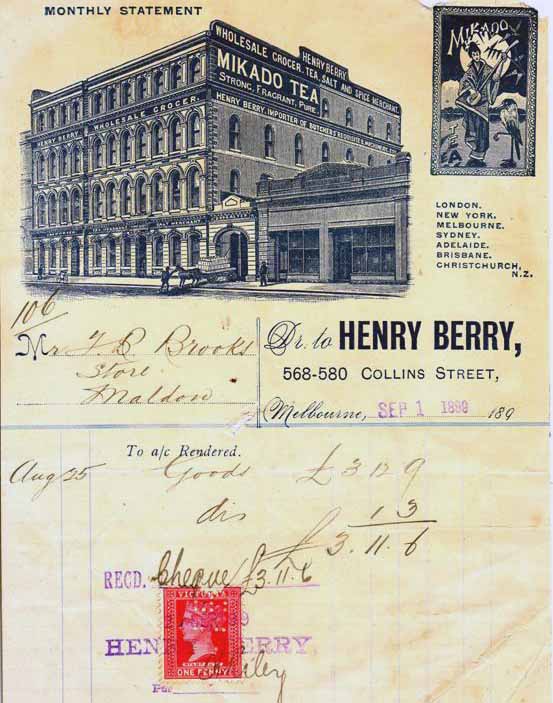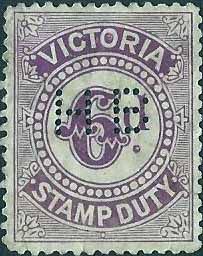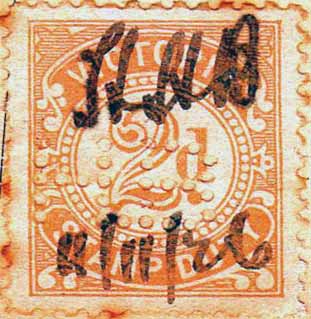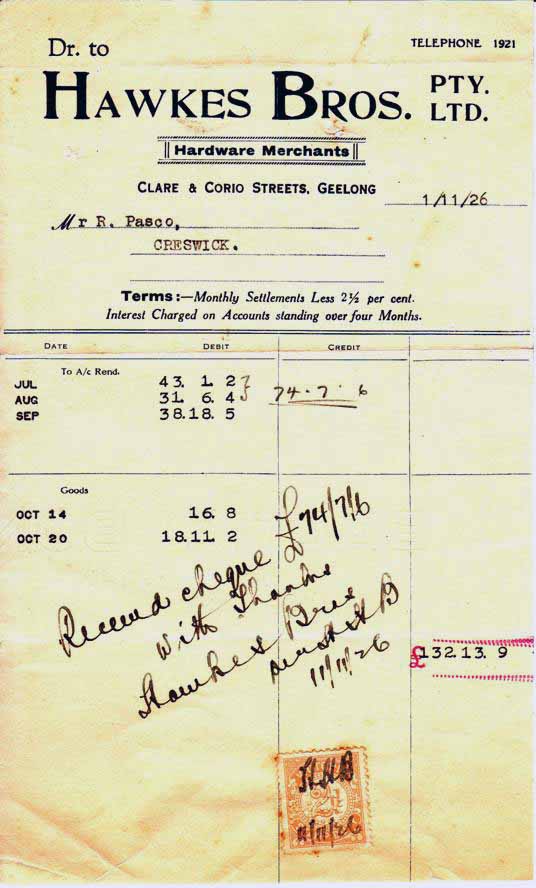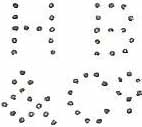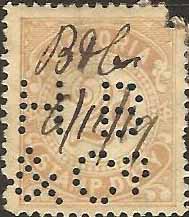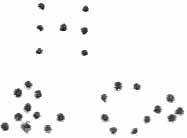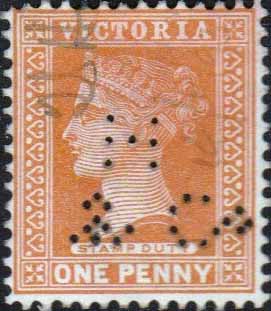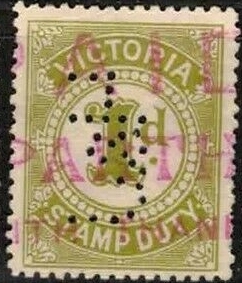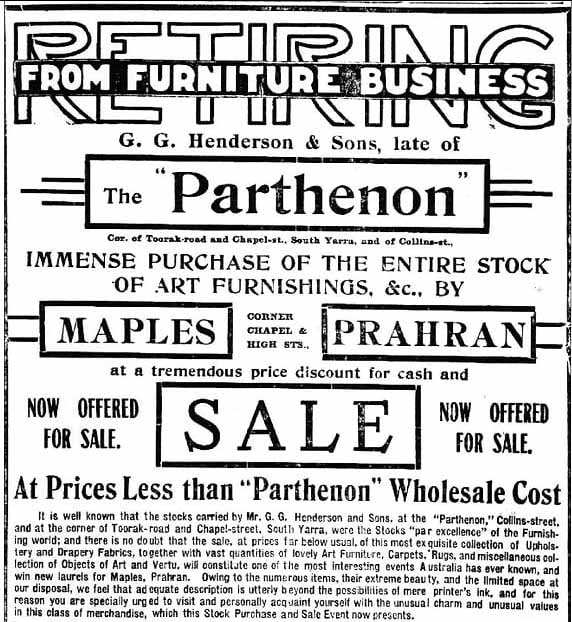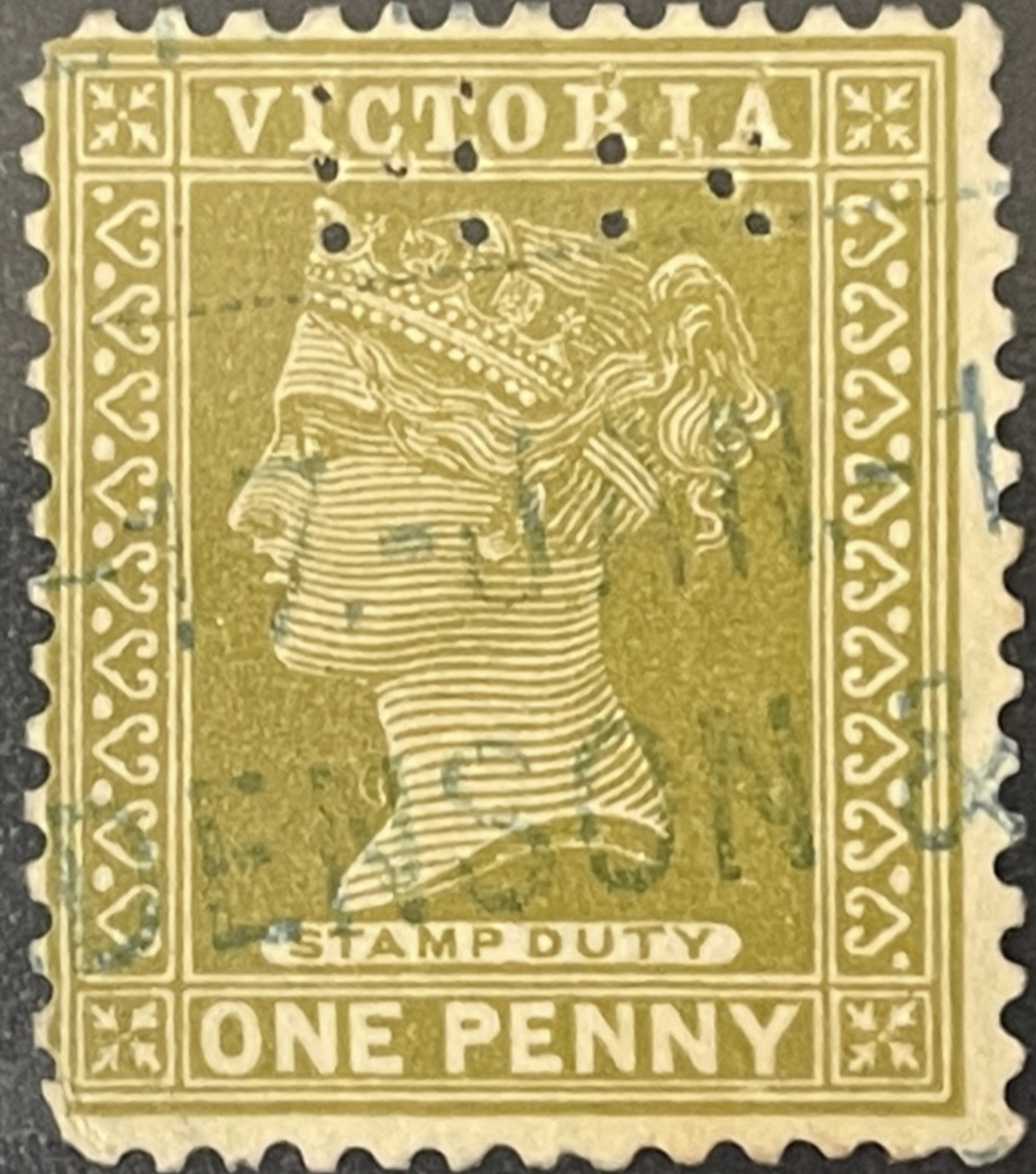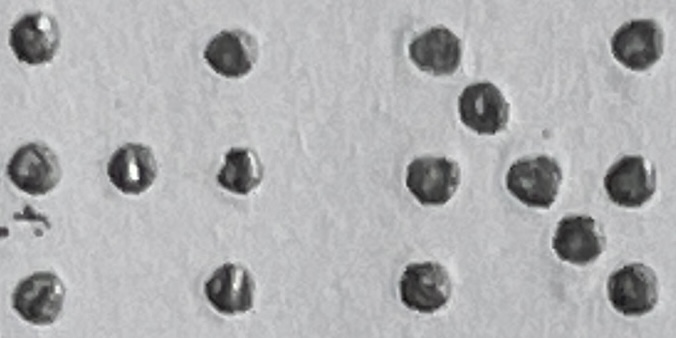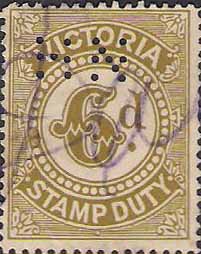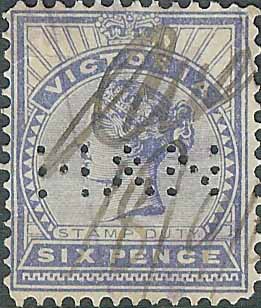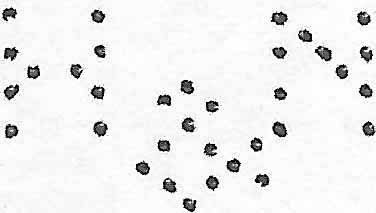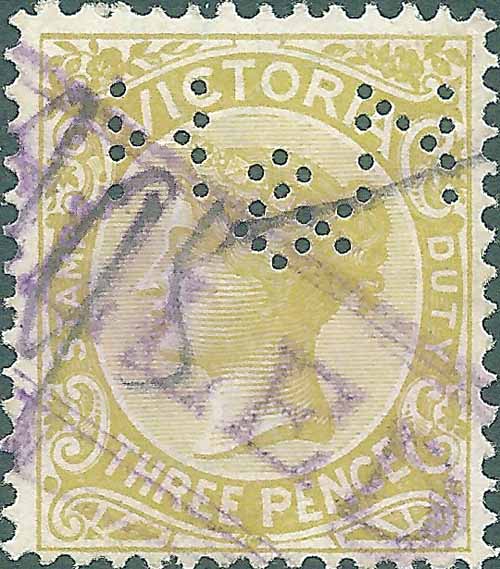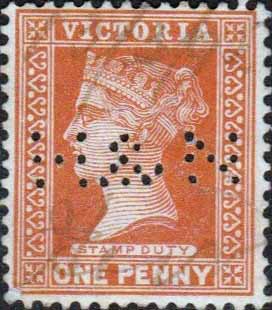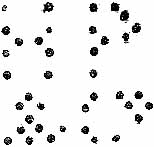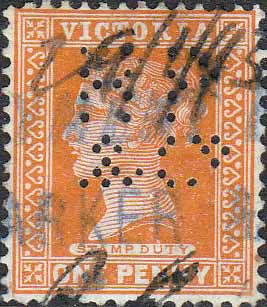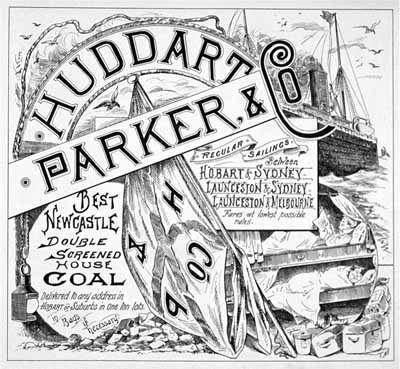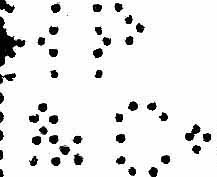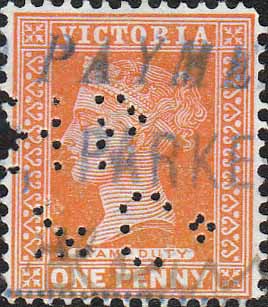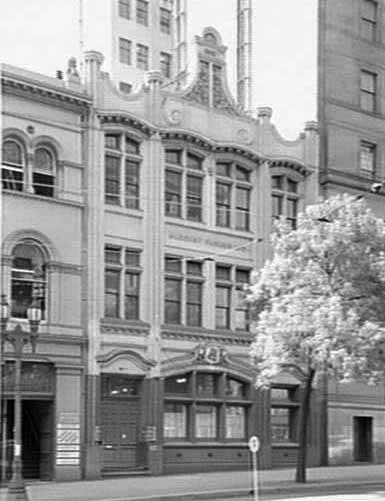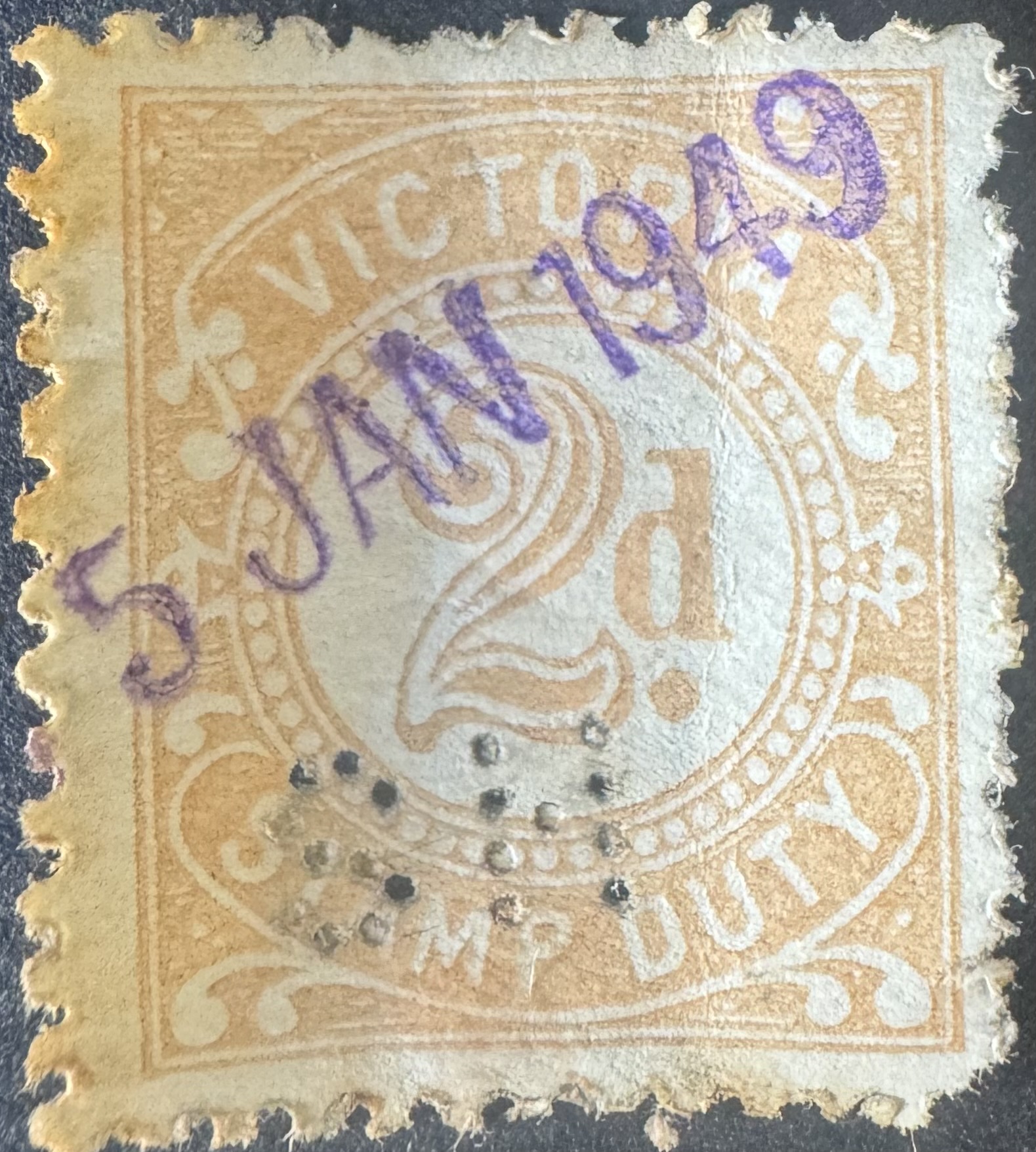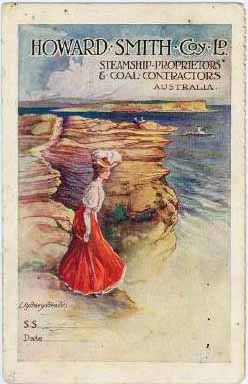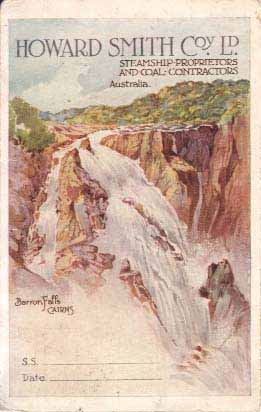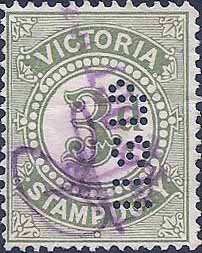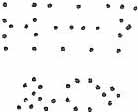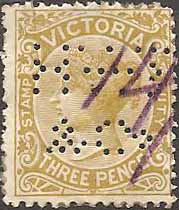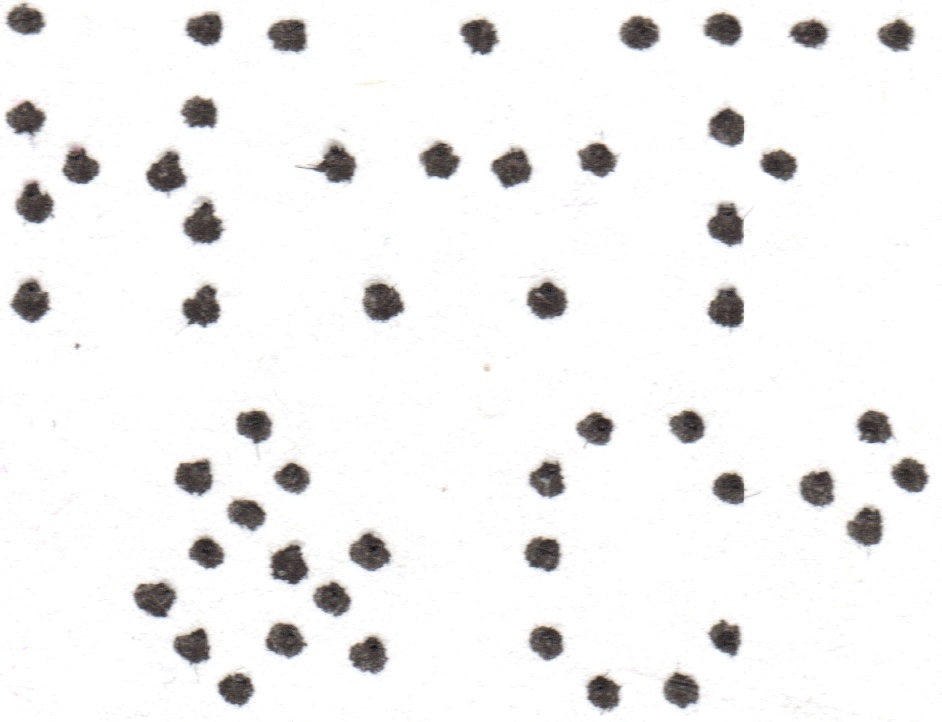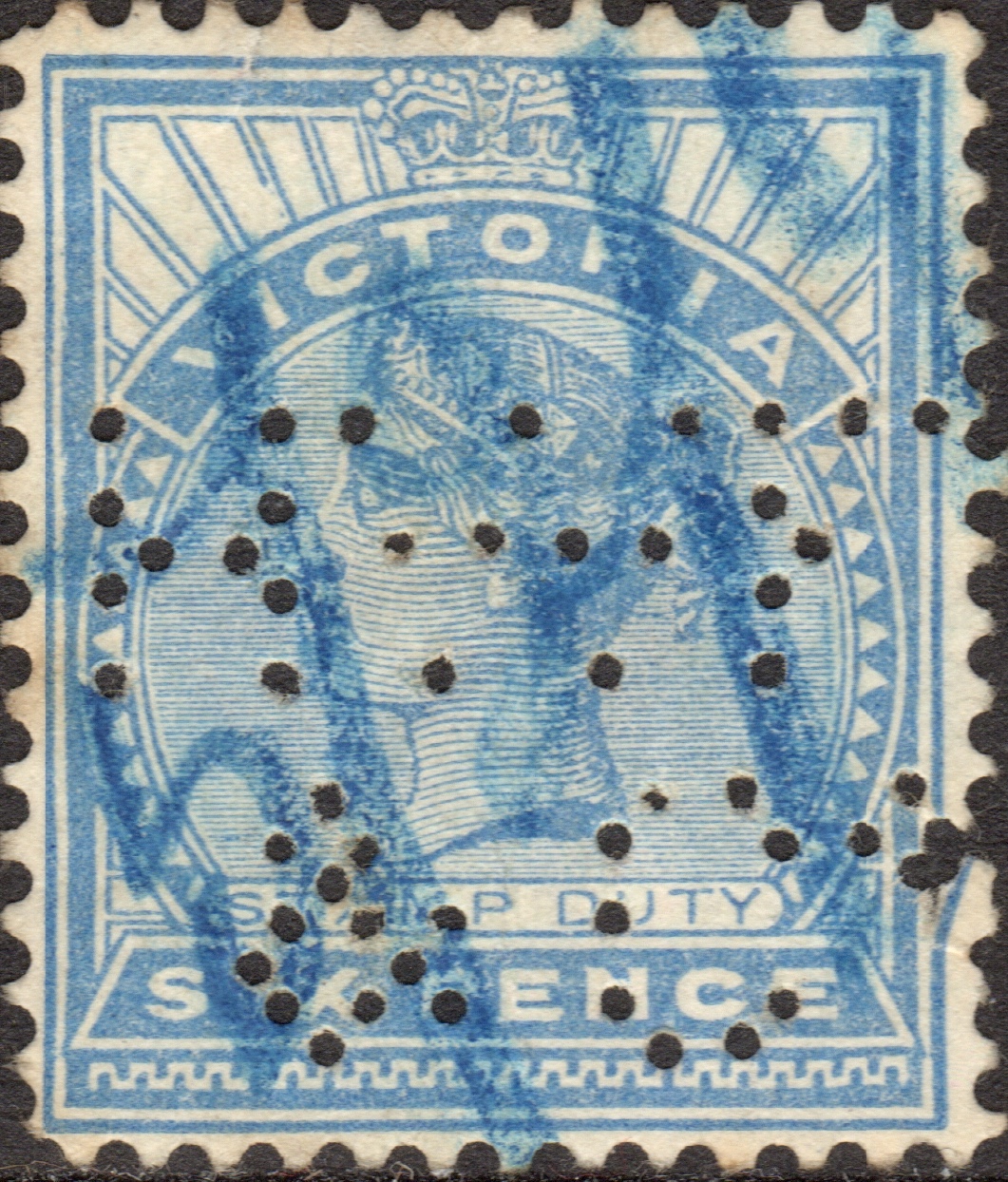|
Private Revenue Perfins of Victoria An Elsmore Coath production The authors would welcome your comments additions or input into this work A B C D E F G H I J K L M N O P Q R S T V W Y Other H -------------------------------------------------------- HB.a
User: Henry Berry Grocers, Importers Address: 568-580 Collins St, Melbourne, VIC Revenue Use: 1886-1899
Series, inscribed 'STAMP DUTY' 1d (shades), 3d, 6d 1911 Series 6d (Violet) Rarity Scale:
1886-1899 Series 1d R2, 3d R4, 6d R4
1911 Series 6d (Violet) R4
Background: *Henry Berry (c1836-1923) was born at Boughton-under-Blean, Kent, England, the second son of Thomas Berry, farmer, and his wife Elizabeth, née Parton.
He was educated at Warman's Canterbury school and in February 1856 he arrived at Melbourne in the Nimrod and in 1859 after some unprofitable years as a grocer he joined John May, a salt and general merchant.
Soon Berry was the sole owner and he expanded the business and was the first in Victoria to attempt the manufacture of salt from local deposits. His factory at Cundare, near Colac, absorbed £10,000 before he admitted defeat. Berry later developed the important deposits at Edithburgh, Yorke Peninsula, which were amalgamated with others at the end of the century to form the Castle Salt Co-operative Co. In 1878 Berry opened a branch of his general merchandise business in Adelaide. Other branches followed in New Zealand 1885, Sydney 1890, Brisbane 1891, and Perth 1896, and he later opened offices in London and Toronto. In 1879 his brother Howard joined the firm and Berry's son, Henry Parton May, became a partner in 1888. By 1899 Berry employees numbered six hundred in Australia and New Zealand.
Berry was known for his philanthropy and his firm had a reputation for integrity. But Berry was a sick man for some years before his death at 86 on 10 January 1923 at Otira, Walpole Street, Kew, Berry had been married three times: first, to Elizabeth Hurst; second, to Louisa Delbridge, by whom he had five sons and seven daughters; and third to Mary Louisa Delbridge, widow of Dr Heffernan, who survived him.
Device: The HB.a device was a single die customized device that came into service in 1896 and was used on the revenue and postage stamps of Victoria and later the postage stamps of Australia until at least 1916.
When comparing your examples to the reference patterns, be careful, as the pattern is symmetrical and indeed we cannot be sure which way up it was intended to be.
In an earlier study of Australian perfins the inverted strike of this pattern was reported as a separate pattern.
The device was in service in the Melbourne office from 1896 until at least 1916. The pattern is often found with a pin missing in the outer leg of the H. This is rare before about 1903 and common afterwards. The device degenerates further and by 1913 the patterns are consistently incomplete. The device is removed from service in 1916 but the company purchases a series of HB/&CO devices, starting in 1912, see HB/&CO.a, but there were later HB/&CO devices that are not found on revenues.
Related Patterns: Refer to other Henry Berry patterns in:
VIC: HB/&CO.a
*Australian Dictionary of Biography
-------------------------------------------------------- HB.b
User: Hawkes Bros. Pty. Ltd. Hardware Merchants, Auto Dealers Address: Clare & Corio St, Geelong, VIC Revenue Use: 1902 Series 6d (Bistre) 1911 Series 6d (Violet) Rarity Scale:
1902 Series 6d (Bistre) R4
1911 Series 6d (Violet) R4
Background: *Hawkes Brothers was established in 1853 by Thomas and Frederick Hawkes and the business grew over time, but retained the family involvement with Tom Hawkes, and Jack Hawkes managing the business. Their huge shop became known as the “House of a million products”, following the style of similar general merchants of the time. Jack and Tom Hawkes were both great sportsmen and Jack played Davis Cup tennis for Australia. Jack's father, Tom Southam Hawkes had inherited the Hawkes Bros hardware business in Geelong form his father Thomas, who had established the business with his brother Frederick in 1853. By the 1920s, Hawkes Brothers hardware business had established itself as both a retail store as well as a major supplier to the local building industry and farming community and there is evidence to suggest that they expanded into the growing automotive sector post WW2. In 1982, Danks purchased the hardware operations of Hawkes Brothers Limited and this included the Thrifty-Link hardware group. Device: The HB.b pattern is made from a temporary die in a single die format. Such devices, which could produce these temporary patterns, were used by some Stamp Vendors in Melbourne from late 1800’s and early part of the 20th Century. There are 3 main settings of the HB.b pattern and they differ in the separation between the H and the B. However only one setting is reported on revenue stamps, which is most likely due to this usage being much less common that use on postage stamps. The pattern is reported in its various layouts over the period 1907 until 1914. As the stamps came from a stamp vendor, they were most likely purchased and punctured in Melbourne, but postmark evidence suggests that they were used in Geelong. Interesting the Geelong office already had the H.B.a (note the extra pin between the H and the B in this pattern), so the purchase of these pre Punctured stamps from a vendor could have been to address periods of high usage. Related Patterns: Refer to other Hawkes Brothers patterns in: VIC: H.B.a * TROVE -------------------------------------------------------- H.B.a
User: Hawkes Bros. Pty. Ltd. Hardware Merchants, Auto Dealers Address: Clare & Corio St, Geelong, VIC Revenue Use: 1886-1899 Series, inscribed 'STAMP DUTY' 1d (shades) 1899 sg 77. 6d 1911 Numeral Series 1d, 3d, 6d 1915 Numeral Series: 2d Rarity Scale:
1886-1899 Series 1d R4
1899 sg 77 6d R4
1911 Numeral Series 1d R2, 3d R3, 6d R4
1915 Numeral Series 2d R4
Background: See HB.b
Device: The H.B.a (note the extra pin between the H and the B in this pattern) device was a single die customized device that came into service in 1900 and was used on the revenue and postage stamps of Victoria and later the postage stamps of Australia until at least 1951.
By the early 1930’s the device was showing signs of wear and tear and it frequently presents with an incomplete strike. This worsens over time but in the late 1930’s and early to mid 1940’s the device is making clean strikes again, indicating that it was repaired or at least serviced around this time. The pattern again shows signs of degradation in the late 1940’s and it is removed from service in 1951.
Related Patterns: Refer to other Hawkes Brothers patterns in:
VIC: HB.b
-------------------------------------------------------- HB/&Co..a
User: Henry Berry Grocers, Importers Address: 568-580 Collins St, Melbourne, VIC Revenue Use: 1915 Series: 2d Rarity Scale:
1915 Series 2d R4
Background: See HB.a Device: The HB/&Co..a device was a single die customized device that came into service in 1912 and was used on the revenue and postage stamps of Victoria and later the postage stamps of Australia until at least 1927. The pattern is clear over its lifetime and this indicates that the device was in sound condition. However, the pattern is quite hard to find on postage stamps and as you will note from the rating, it is very rare on revenue stamps. The HB/&Co..a pattern has been erroneously attributed to the companies Adelaide office. Henry Berry certainly had an office in Adelaide since 1878, but there have been no reports of perfin patterns or devices used by this office. This report may have been based on the fact that the pattern has been seen on the postage stamps of South Australia. This usage is likely to be cross State usage of remainders of States stamps that occurred in 1912 – 13, prior to the introduction of the first Commonwealth issues. Revenue use of HB/&Co..a is rare, and as stated above use on postage stamps is also scarce, but all the examples of the pattern that the authors have sighted are on the postage or revenue stamps of Victoria or the postage stamps of Australia, but these are generally postmarked in Melbourne. Related Patterns: Refer to other Henry Berry patterns in: VIC: HB.a -------------------------------------------------------- HB/&K.a
User: Harrison Brothers & Kettle Store Keepers Address: Murphy St, Wangaratta, VIC Revenue Use: Rarity Scale:
Background: *The company of Harrison Brothers and Kettle came into existence in 1890 when the four Harrison brothers and a Mr Kettle purchased the “Universal Provider” business of Mr W Meldrum, including the large premises in Murphy St, Wangaratta. The company expanded with the purchase of the nearby Moyhu Co-Operative in February 1907. In March 1909, the company’s premises were guttered by a huge fire which destroyed all stock and left just the four walls of their premises standing. The company never recovered from this fire and in January 1910 they assigned all of their assets to their creditors. In May 1910 the stock of what had been Harrison Brothers & Kettle was acquired by Messer’s Callander and Forer who went onto trade in Wangaratta as “The Big Store”. Device: The HB/&K.a device was a single die customized device that came into service in 1902 and was used on the revenue and postage stamps of Victoria until at least 1907. The pattern is uncommon on postage stamps but extremely rare on revenues. The device appeared to be sound over its short lifetime, so there may be usage later than 1907, however the device would have almost certainly been destroyed in the fire of 1909. Related Patterns: Nil *Trove -------------------------------------------------------- H&Co.a
User: Address: Melbourne, VIC Revenue Use: 1886-1899 Series, inscribed 'STAMP DUTY' 1d Rarity Scale:
1886-1899 Series 1d R4
Background: Unknown
Related Patterns: Nil -------------------------------------------------------- H&J.a
User: Henderson & Jupp Furnishers, Decorators and Upholsterers Address: 264 Chapel St, Prahran, VIC Other locations see Background below. Revenue Use: Reported but not seen Rarity Scale:
Background: *George Glen Henderson was born in Edinburgh in 1859. He migrated at the age of 17 with his parents and two younger sisters, arriving in Sydney aboard the Hankow in February, 1877. G.G. Henderson died at the home of his son-in-law in March, 1937. Robert William Jupp was born in Victoria in 1858. He died at his home,’Duclair’, in Middle Brighton in November, 1915. The partnership of Henderson, Jupp & Watson (“late with Maple & Co, London, and Callis Hill & Co, Melbourne”) was formed in 1891. The business advertised as “Art furnishers & Decorators” specialising in window furnishings and wall papers, and opened at the lavishly named ‘The Parthenon” 246 Chapel Street, opposite Prahran town hall. The following year (1892), the firm provided the platform decorations for the 56th Promenade Concert at the Exhibition Buildings. The partnership with Watson did not last, apparently ending in 1892, the business continuing as Henderson & Jupp. In 1900, the building at 246 Chapel St was sold, but the firm continued to occupy the premises. In 1911, Henderson, Jupp now advertising as furnishers, art decorators and upholsterers opened new showrooms at 589-595 Collins St West, “opposite the tram terminus, one minute from Spencer St Station”. There was also another business, styled Jupp & Henderson, modellers and sculptors, in Lydiard Street, Ballarat. The partnership of George Henderson and Robert Jupp of ‘The Parthenon’, (dealing in art furnishings, decoration and upholstery) and 589 Collins St, was dissolved in March 1915, the business continuing under the style of G.G. Henderson & Sons. While retaining the Collins Street premises, the firm opened a second showrooms, in late 1917, at the corner of Chapel St and Toorak Road, South Yarra. In January, 1918, George Glen Henderson was forced to “convey and assign all his estate, property and effects” for the realization and benefit of his creditors. Henderson retired from the business, and an “immense purchase of the entire stock of art furnishings” was made by Maples (corner of Chapel and High streets, Prahran). The rest of the stock was offered below “wholesale cost” to the public and G.G. Henderson & Sons ceased trading by April, 1918. Device: The H&J.a device was a single die customized device that was only in service for a short period of time in 1903. Postmark evidence on postage stamps almost always shows Prahran circular date stamps or associated #69 Barred numerals. The pattern is consistent over the short usage period and there is no evidence that the device fell into disrepair, so it is hard to explain the short period of service. Revenue use has been reported, but given the fact that device was in service for such a short period of time, and that such use tends to be less common, combines to make this a very elusive pattern on revenue stamps. Related Patterns: Nil *Jenny O’Donnell Research
-------------------------------------------------------- HN.a
User: Holdenson & Nielson Dairy Produce Merchants Address: 521 Flinders St, Melbourne, VIC Revenue Use: 1886-1899 Series, inscribed 'STAMP DUTY' 1d (shades) Rarity Scale:
1886-1899 Series 1d R4 Background: *Poul Jorgen Holdenson was born in February 1863, in Jutland, Denmark, where his parents ran a dairy farm. In 1879, at the age of 16, Holdenson left for Victoria with his brother and a school friend, Andreas Jepsen Nielson (born 1861). The trio initially tried their hand at gold digging, but Holdenson soon found more rewarding work as a farm labourer. Moving to Melbourne, he bought a restaurant which he renovated and turned into a thriving business. Using the money from the sale of the restaurant, he bought a stall at Melbourne’s Eastern Market where he sold wholesale produce. In 1886, Andreas Nielson returned to Melbourne and suggested they form a partnership focusing on dairy produce. Trading as Holdenson & Nielson, at 75-76 Eastern market, Melbourne, the business collected cream from milk-skimming stations set up in country areas, rapidly expanding to take “consignments of dairy produce of all descriptions”. In 1889, the company moved to premises in Flinders Lane, which soon proved too small. By 1897 Holdenson & Nielson had moved to a large, 3 storey building at No. 3 Farm & Dairy Produce Markets in Flinders St, (nos. 521-527 Flinders St,near King St) which included the city factory and refrigerating works. The firm advertised as agents for the intercolonial markets and shipments of butter and cheese to London and oversea ports. In the 1890s, Holdenson & Nielson also acted as agents for dairy farm sales and manufactured award winning butter brands. The company expanded throughout Victoria, (especially in west Gippsland) buying up small, country butter factories and building new factories. (In 1910, John Monash would be the engineer for the new Lake Boga Butter factory). The company introduced new technology to the Victorian dairy industry as sole agents of Burmeister & Wain of Copenhagen, manufacturers of the new ‘Perfect’ cream separator (1901) and ‘Perfect’ pasteuriser (1905) and as agents for Newtons Ltd (England) ‘AB’ oil engines for driving dairying machines. In 1907, Holdenson & Nielson, as sole Victorian agents, introduced and installed the new ‘Hartnett’ milking machines. By 1905, Holdenson & Nielson was the largest butter manufacturer in Melbourne. In 1908, Holdenson acquired the business of Fresh Foods & Frozen Storage Pty Ltd resulting in the “amalgamation of two of the leading butter manufacturers and trading institutions in Melbourne”. The new company traded (from 1 July, 1905) under the style of Holdenson & Nielson Fresh Food Pty Ltd at 521-527 Flinders St Melbourne, with P.J. Holdenson as managing director. Holdenson & Nielson Fresh
Food Pty Ltd was still trading under this style in
1956, but would later become part of the
Petersville business. Andreas Nielson left Australia
due to ill health (possibly tuberculosis) for
Switzerland in 1902. He died in Davos, in
December, 1903, at the age of 42. Paul John Holdenson died at his daughter’s home in Sydney in March, 1948, aged 85. A well-known philanthropist, he was founder and president of the Danish- Australian Chamber of Commerce, a member of the Melbourne Chamber of Commerce, periodically president of the Danish Club between 1911 and 1942, held board positions on various industrial and mining companies and was for many years Danish Consul General in Victoria. Device: The HN.a pattern is made
from a temporary die in a single die format. Such
devices, which could produce these temporary
patterns, were used by some Stamp Vendors in
Melbourne from late 1800’s and early part of the
20th Century. There are 3 main settings of the HN.a pattern and they differ in the separation between the H and the N. However only one setting is reported on revenue stamps, which is most likely due to this usage being much less common than use on postage stamps. The pattern is reported in its various layouts over the period 1901 until 1903. The company were frequent users of temporary perfin patterns with at least 15 HN and at least 5 H&N patterns reported over the period 1896 until 1930. Only a few of these are reported on revenue stamps. Related Patterns: Refer to other Holdenson & Nielson patterns in: VIC: HN.b, H&N.a, H&N.b, H&N.c*Jenny O'Donnell Research -------------------------------------------------------- HN.b
User: Holdenson & Nielson Dairy Produce Merchants Address: 521 Flinders St, Melbourne, VIC Revenue Use: 1902 Series 6d (Bistre) Rarity Scale:
1902 Series 6d R4
Background: See HN.a Device: The HN.b pattern is made from a temporary die in a single die format. Such devices, which could produce these temporary patterns, were used by some Stamp Vendors in Melbourne from late 1800’s and early part of the 20th Century. There are 2 main settings of the HN.b pattern and they differ in the separation between the H and the N. In addition, there are some less common settings found in the period 1914 – 1920. However only one setting is reported on revenue stamps, which is most likely due to this usage being much less common than use on postage stamps. The pattern is reported in its various layouts over the period 1903 until at least 1920. The company were frequent users of temporary perfin patterns with at least 15 HN and at least 5 H&N patterns reported over the period 1896 until 1930. Only a few of these are reported on revenue stamps. Related Patterns: Refer to other Holdenson & Nielson patterns in: VIC: HN.a, H&N.a, H&N.b, H&N.c -------------------------------------------------------- H&N.a User: Holdenson & Nielson Dairy Produce Merchants Address: 521 Flinders St, Melbourne, VIC Revenue Use: 1886-1899 Series, inscribed 'STAMP DUTY' 1d (shades), 6d Rarity Scale:
1886-1899 Series 1d R4, 6d R4
Background: See HN.a
Device: The H&N.a pattern is made from a temporary die in a single die format. Such devices, which could produce these temporary patterns, were used by some Stamp Vendors in Melbourne from late 1800’s and early part of the 20th Century. There are 16 main settings of the H&N.a pattern and they differ in the separation between the H and & and the N. However only 4 settings are reported on revenue stamps which is most likely due to this usage being much less common than use on postage stamps. The pattern is reported in its various layouts over the period 1896 until 1900. The company were frequent users of temporary perfin patterns with at least 15 HN and at least 5 H&N patterns reported over the period 1896 until 1930. Only a few of these are reported on revenue stamps. Related Patterns: Refer to other Holdenson & Nielson patterns in: VIC: HN.a, HN.b, H&N.b, H&N.c -------------------------------------------------------- H&N.b User: Holdenson & Nielson Dairy Produce Merchants Address: 521 Flinders St, Melbourne, VIC Revenue Use: 1886-1899 Series, inscribed 'STAMP DUTY' 3d Rarity Scale:
1886-1899 Series 3d R4
Background: See HN.a Device: The H&N.b pattern is made from a temporary die in a single die format. Such devices, which could produce these temporary patterns, were used by some Stamp Vendors in Melbourne from late 1800’s and early part of the 20th Century. This is an extremely rare pattern and only a single setting is reported. This pattern has only been reported on revenue stamps and may not have existed on the more common postage stamps. The example recorded does not have any manuscript date but usage is most likely to have been prior to 1900. Related Patterns: Refer to other Holdenson & Nielson patterns in: VIC: HN.a, HN.b, H&N.a, H&N.c -------------------------------------------------------- H&N.c User: Holdenson & Nielson Dairy Produce Merchants Address: 521 Flinders St, Melbourne, VIC Revenue Use: 1886-1899 Series, inscribed 'STAMP DUTY' 1d Rarity Scale:
1886-1899 Series 1d R4
Background: See HN.a
Device: The H&N.b pattern is made from a temporary die in a single die format. Such devices, which could produce these temporary patterns, were used by some Stamp Vendors in Melbourne from late 1800’s and early part of the 20th Century. This is an extremely rare pattern and only a single setting is reported. This pattern has only been reported on revenue stamps and may not have existed on the more common postage stamps. The example recorded does not have any manuscript date but usage is most likely to have been prior to 1900. Related Patterns: Refer to other Holdenson & Nielson patterns in: VIC: HN.a, HN.b, H&N.a, H&N.b -------------------------------------------------------- HP/&Co.a User: Huddart Parker & Co Shipping Address: 466 Collins St, Melbourne, VIC Revenue Use: 1886-1899 Series, inscribed 'STAMP DUTY' 1d Rarity Scale:
1886-1899 Series 1d R4
Background: *Initially Mr Parker, Captain Webb & John Traill were partners in a shipping business later James Huddart joined and it became known as 'Huddart, Parker & Co' The company was floated into a Limited Liability Company on 23 Jan 1889. At this time the Company Directors were: Jas Huddart, Thos. J. Parker, Thos. Webb, John Traill & J. E. Parker (son of J. J. Parker). The company name is often misspelt 'Huddard' Device: The HP/&Co.a pattern is made from a temporary die in a single die format. Such devices, which could produce these temporary patterns, were used by some Stamp Vendors in Melbourne from late 1800’s and early part of the 20th Century. There are 4 main settings of the HP/&Co.a pattern and they differ in the separation between the four letters. However only one setting is reported on revenue stamps, which is most likely due to this usage being much less common than use on postage stamps. The pattern is reported in its various layouts over the period 1894 until 1899. The company were infrequent users of temporary perfin patterns and all of their patterns are rare and especially rare on revenues. Related Patterns: refer to other Huddart Parker patterns in: VIC: HP/&Co.b (below) * Huddart Parker Offices 466 Collins St, Melbourne, VIC *Tasmanian Archive and Heritage Office *Trove -------------------------------------------------------- HP/&Co.b
User: Huddart Parker & Co Shipping Address: 466 Collins St, Melbourne, VIC Revenue Use: 1886-1899 Series, inscribed 'STAMP DUTY' 1d Rarity Scale:
1886-1899 Series 1d R4
Background: See HP&Co.a above Device: The HP/&Co.b pattern is made from a temporary die in a single die format. Such devices, which could produce these temporary patterns, were used by some Stamp Vendors in Melbourne from late 1800’s and early part of the 20th Century. This pattern is extremely rare and there are only 2 settings of the pattern reported. They differ in the separation between the four component letters. However only 1 setting is reported on revenue stamps which is most likely due to this usage being much less common than use on postage stamps. The pattern is reported in its various layouts over the period around 1895. The company were infrequent users of temporary perfin patterns and all of their patterns are rare and especially rare on revenues. Related Patterns: refer to other Huddart Parker patterns in: VIC: HP/&Co.a (above) *State Library of Victoria * Huddart Parker Offices 466 Collins St, Melbourne, VIC -------------------------------------------------------- HS.a
User: Howard Smith Co Ltd Shipping Agents Address: Geelong, VIC Revenue Use: 1915 Series: 2d Rarity Scale:
1915 Series 2d R4 Background: *Captain William Howard Smith arrived in Melbourne from Hull (Yorkshire) in 1854 and formed Howard Smith Limited and commenced regular voyages between Melbourne and Geelong. In 1864 he extended this to a Melbourne to Sydney passenger and cargo service and later included Newcastle (1868), then Maryborough, Adelaide, Brisbane and Rockhampton by 1880. This network was further extended to include Western Australia and Far North Queensland. Smith had established himself well in coal importation and trading and this and the growth in his passenger and general cargo services lead to the accumulation of a large fleet. In the late 1870s he had three of his sons in the partnership and they took charge of the Melbourne, Sydney and Brisbane offices. In 1883 the firm became a limited liability company, William Howard Smith and Sons Ltd. He was the managing director at Melbourne before he retired from active management in 1884 but he continued as chairman until 1887. Smith died in Melbourne in March 1890 aged 76, survived by his wife and seven sons and two daughters. The business was reorganized under the control of four sons, Edmund (Melbourne), Walter (Geelong), Harold (Sydney), and Ormond (Brisbane). In 1901 the company became Howard Smith Company Ltd in 1901 and later in 1914 it changed its name to Howard Smith Limited and it expanded from its base in the coastal shipping trade into the mining and sugar industries and later engineering, hardware, towage and safety. The shipping activities continued to grow until the late 1940’s when the company ceased their involvement in the passenger trade. In 1969 Howard Smith withdrew from the shipping business in and then in 2001 sold their towage interests. The company and its remaining hardware interests were absorbed by Wesfarmers Ltd., Perth, the owners of the Bunnings chain. At this time Howard Smith Ltd. was delisted from the Australian Stock Exchange. Device: Most likely a single die device, this HS.a device appears to be a conversion of the more common HSCO device. (see HSCO.a below) The distribution of the pattern of the HS device is however different and usage seems to have been limited to Geelong with some Melbourne postmarks reported. The device was in service from at least 1931 (possibly earlier) until at least 1951. Related Patterns: refer to other
Howard Smith patterns in: WA: HSCO.a * Australian Dictionary of Biography -------------------------------------------------------- HSCo.a User: Howard Smith Co Ltd Shipping Agents Address: 35 Market St, Melbourne, VIC Revenue Use: 1911 Series 1d Rarity Scale:
1911 Series 1d R3 Device: The HSCO.a device came into service in about 1905 and remained in use until at least 1915. The HSCO.a device is most likely a single die customised device. The associated HSCO.a pattern is found on revenue and postage stamps with usage across Australia supported by postmark evidence, including, Sydney, Newcastle, Perth, Fremantle, Brisbane, Rockhampton, Maryborough, MacKay, Townsville, Cairns, Adelaide, Port Pirie, Petersburg, Murray Bridge, Port Adelaide, Melbourne and Geelong. The strikes found used in the various remote locations are essentially identical, so it is difficult to say if they were a series of identical dies in separate devices or a device located centrally (most likely the head office in Melbourne) which perforated stamps for dispatch to user areas. The central location would have faced the challenge of obtaining revenue and postage stamps of the various States and receiving these and returning them to user areas. More likely that the devices were a series of identical located at least in the main State office in each State. This argument for remote but similar devices, is supported by the fact that company subsequently replaced the HSCO device(s) with a range of devices of similar appearance in the HSLD format and that these devices were allocated to their various remote offices around Australia. Related Patterns: refer to other Howard Smith patterns in: NSW: HSLD.a
QLD: HSCO.a HSLD.b HSLD.c
SA: HSCO.a
VIC: HS.a, HSLD.a
WA: HSCO.a -------------------------------------------------------- HSLD.a
User: Howard Smith Co Ltd Shipping Agents Address: 35 Market St, Melbourne, VIC Revenue Use: 1911 Series 1d Rarity Scale:
1911 Series 1d R3
Background: See HS.a Device: The HSLD.a device was a single die customized device that came into service in 1935 and was used on the revenue stamps of Victoria and the postage stamps of Australia until at least 1951.
As discussed in HSCO.a, the company used many HSLD devices, as many as 20, and they were rather similar. They were progressively introduced after the withdrawal of the HSCO.a device in 1915. But this Melbourne pattern is easy to identify as it is one of the later devices issued and it has a distinctive and more compact “S”.
The device featured rather thick pins and during its 16 year life span it almost always produced clear readable strikes.
The company had fewer than 10 devices in service following WW2 and this HSLD.a device was one of the last to remain in service.
Related Patterns: refer to other Howard Smith patterns in: NSW: HSLD.a
QLD: HSCO.a HSLD.b HSLD.c
SA: HSCO.a
VIC: HS.a, HSCO.a
-------------------------------------------------------- HWF/&Co.a User:
Unknown Address:
VIC Revenue
Use: 1886-1899
Series, inscribed 'STAMP DUTY' 3d (shades) Rarity Scale: 1886-1899 Series 3d R4 Background:
Unknown Device: The
HWF/&Co.a pattern is
made from a temporary die in a single die
format. Such devices, which could produce
these temporary patterns, were used by some
Stamp Vendors in Melbourne from late 1800’s
and early part of the 20th Century. There are 2
main settings of the HWF/&Co.a pattern and
they differ in the separation between the
five letters. However only 1 setting is
reported on revenue stamps which is most
likely due to this usage being much less
common than use on postage stamps. The pattern is
very rare and there are few reports so
evidence from manuscripts and postmarks is
limited. We would estimate based on the
issues that the pattern is reported on that
it was used in the mid to late 1890’s. The company
were infrequent users of temporary perfin
patterns and all of their patterns are rare
and especially rare on revenues. Related
Patterns: HWF/&Co.b
-------------------------------------------------------- HWF/&Co.b
User: Unknown Address: VIC Revenue Use: 1886-1899
Series, inscribed 'STAMP DUTY' 6d Rarity Scale:
1886-1899 Series 6d R4
Background: Unknown Device: See
HWF/&Co.a Related Patterns: HWF/&Co.a -------------------------------------------------------- A B C D E F G H I J K L M N O P Q R S T V W Y Other © copyright 2011 |

